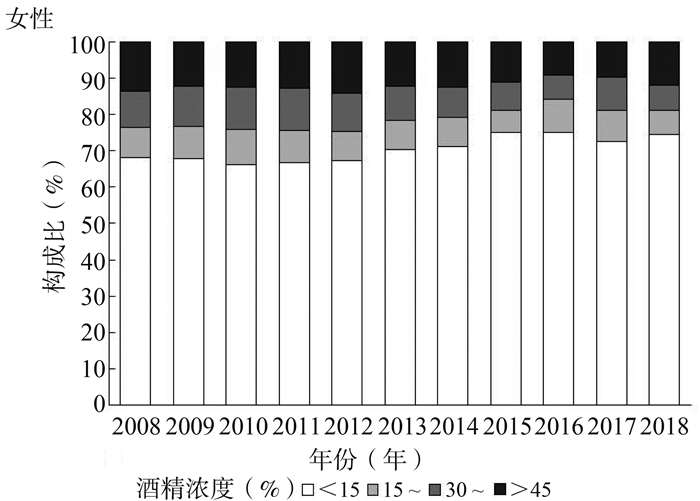Analysis on the trend of drinking behavior in a healthy physical examination group in urban area of Beijing from 2008 to 2018
-
摘要:
目的 描述2008-2018年北京某机构20岁及以上体检人群饮酒行为特征变化趋势。 方法 通过自填式半定量问卷获得研究对象饮酒行为信息,估计研究对象的饮酒行为特征,并采取2010年北京市人口普查数据作为标准人口,对均值和率进行加权处理。 结果 2008-2018年该健康体检人群的男、女性饮酒率均呈下降趋势,其中男性标化饮酒率下降达15.00%,女性标化饮酒率下降约2.00%。男性戒酒率呈下降趋势,10年下降1个百分点。在饮酒者中,男、女性人均每日酒精消费量呈下降趋势,10年来,男性人均每日酒精消费量下降3.21 g,女性下降1.45 g;过量饮酒率和暴饮率仅在女性中呈下降趋势,分别下降3.04%和4.53%。 结论 2008-2018年北京市健康体检人群的饮酒率、饮酒者人均每日酒精消费量呈下降趋势,女性过量饮酒率和暴饮率呈下降趋势。 Abstract:Objective To describe the trend of drinking behavior in Beijing among people aged 20 years and above in a physical examination facility during 2008-2018. Methods Self-reported semi-quantitative questionnaires were used to collect the information on the drinking behavior of each participant when visiting the facility. Means and percentages were used to describe the characteristics of drinking behavior of the participants, and were standardized according to the Beijing population census in 2010. Results From 2008 to 2018, the drinking rate of both men and women decreased significantly, the standardized drinking rate of men dropped by 15.00 percents in the past 10 years, while the corresponding number of women were about 2.00 percents. Men who quit drinking were decreasing by 1 percent over 10 years. Among the daily drinkers, both genders showed a decreasing trend on the alcohol consumption, the number declined 3.21 g/d for men and 1.45 g/d for women over 10 years. Meanwhile, the percentages of excessive drinking and binge drinking decreased by 3.04 percents and 4.53 percents respectively; but such trends were not observed in men. Conclusions The drinking behaviors in the physical examination population in Beijing showed a decreasing trend from 2008 to 2018. -
Key words:
- Alcohol drinking /
- Trend /
- Beijing /
- Physical examination population
-
表 1 2008-2018年北京某机构20岁及以上体检人群性别年龄分布
Table 1. Gender and age distribution of physical examination population aged 20 years and above in an institution in Beijing from 2008 to 2018
年份(年) 人数 性别(%) 年龄组(岁,%) 男 女 <40 40~ ≥60 2008 20 214 57.8 42.2 49.9 43.4 6.7 2009 20 688 55.7 44.3 48.4 45.1 6.5 2010 21 654 56.7 43.3 46.5 45.9 7.6 2011 23 622 55.8 44.2 45.4 47.5 7.1 2012 28 965 54.8 45.2 42.6 50.2 7.2 2013 32 925 54.8 45.2 43.4 48.7 7.9 2014 27 986 55.2 44.8 48.1 43.0 8.9 2015 26 086 54.9 45.1 50.1 41.4 8.5 2016 22 970 53.9 46.1 41.7 47.9 10.4 2017 23 889 53.5 46.5 41.5 48.2 10.3 2018 29 609 54.6 45.4 41.7 48.9 9.4 合计 278 608 55.2 44.8 45.2 46.6 8.2 表 2 2008-2018年北京某机构20岁及以上体检人群标化饮酒率(%)
Table 2. Standardized drinking rate of physical examination population aged 20 years and above in an institution in Beijing from 2008 to 2018 (%)
年份(年) 男性 女性 饮酒 戒酒 不饮酒 饮酒 戒酒 不饮酒 2008 39.7(0.5) 4.7(0.3) 55.7(0.5) 6.4(0.4) 1.4(0.1) 92.2(0.4) 2009 38.5(0.5) 4.8(0.3) 56.7(0.5) 5.8(0.3) 1.4(0.1) 92.8(0.3) 2010 37.1(0.5) 4.3(0.2) 58.6(0.5) 5.5(0.3) 1.5(0.1) 92.9(0.3) 2011 38.6(0.5) 4.7(0.2) 56.7(0.5) 6.0(0.3) 1.4(0.1) 92.6(0.3) 2012 36.4(0.4) 4.4(0.2) 59.1(0.4) 5.6(0.2) 1.3(0.1) 93.1(0.3) 2013 33.4(0.4) 4.6(0.2) 62.1(0.4) 5.0(0.2) 1.4(0.1) 93.6(0.2) 2014 33.2(0.4) 4.2(0.2) 62.6(0.4) 5.4(0.2) 1.5(0.1) 93.1(0.2) 2015 30.9(0.4) 4.2(0.2) 65.0(0.4) 5.3(0.2) 1.3(0.1) 93.4(0.3) 2016 27.6(0.4) 3.5(0.2) 68.8(0.4) 4.8(0.2) 1.4(0.1) 93.8(0.3) 2017 27.3(0.4) 3.9(0.2) 68.9(0.4) 4.5(0.2) 1.0(0.1) 94.5(0.2) 2018 25.1(0.4) 3.7(0.2) 71.1(0.4) 4.1(0.2) 1.3(0.1) 94.6(0.2) 变化趋势系数 -1.50 -0.11 1.61 -0.19 -0.03 0.22 P值 < 0.001 0.013 < 0.001 < 0.001 0.421 < 0.001 注:括号外数据为标化饮酒率点估计,括号内数据为相应标准误。 表 3 2008-2018年北京某机构20岁及以上体检人群饮酒者标化饮酒特征
Table 3. Standardization of drinking characteristics in physical examination population aged 20 years and above in an institution in Beijing from 2008 to 2018
年份(年) 男性 女性 酒精摄入量(g/d) 过量饮酒率(%) 暴饮率(%) 酒精摄入量(g/d) 过量饮酒率(%) 暴饮率(%) 2008 23.3 29.4 33.0 7.5 12.7 9.9 2009 24.4 31.1 34.6 9.4 15.9 14.3 2010 25.8 35.5 38.6 7.4 13.5 12.3 2011 26.6 36.8 40.7 8.5 15.2 11.2 2012 25.5 35.2 39.4 8.1 13.8 11.9 2013 24.9 34.2 37.7 8.4 14.1 11.6 2014 23.8 31.8 35.4 8.4 13.4 10.1 2015 23.0 31.0 34.6 8.6 13.7 8.4 2016 22.6 31.5 35.0 5.8 9.4 7.0 2017 22.5 31.7 36.2 7.3 13.4 10.3 2018 21.7 32.2 36.1 6.8 11.0 7.7 变化趋势系数 -3.21 -0.96 -0.46 -1.45 -3.04 -4.53 P值 0.006 0.677 0.848 0.048 0.009 0.003 -
[1] GBD 2016 Alcohol Collaborators. Alcohol use and burden for 195 countries and territories, 1990-2016: a systematic analysis for the Global Burden of Disease Study 2016[J]. Lancet, 2018, 392(10152): 1015-1035. DOI: 10.1016/S0140-6736(18)31310-2. [2] World Health Organization. International guide for monitoring alcohol consumption and related harm[M]. Geneva: World Health Organization, 2000. [3] 北京市人民政府. 北京市人民政府关于印发健康北京"十二五"发展建设规划的通知[J]. 北京市人民政府公报, 2011, (18): 33-47. https://www.cnki.com.cn/Article/CJFDTOTAL-BMZB201118006.htmPeople's Government of Beijing Municipality. Circular of Beijing Municipal People's Government on the issuance of the development and construction plan of healthy Beijing during the 12th five-year plan period[J]. Bulletin of Beijing Municipal People's Government, 2011, (18): 33-47. https://www.cnki.com.cn/Article/CJFDTOTAL-BMZB201118006.htm [4] 新华通讯社. 中共中央、国务院印发《"健康中国2030"规划纲要》[EB/OL]. (2016-10-25)[2021-01-09]. http://www.gov.cn/xinwen/2016-10/25/content_5124174.htm.Xinhua News Agency. The Chinese Communist Party Central Committee and the State Council issued the "Healthy China 2030" program[EB/OL]. (2016-10-25)[2021-01-09]. http://www.gov.cn/xinwen/2016-10/25/content_5124174.htm. [5] World Health Organization. Global status report on alcohol and health 2018[R]. Geneva: World Health Organization, 2018. [6] Cochrane J, Chen HH, Conigrave KM, et al. Alcohol use in China[J]. Alcohol Alcohol, 2003, 38(6): 537-42. DOI: 10.1093/alcalc/agg111. [7] 中国营养学会. 中国居民膳食指南[M]. 北京: 人民卫生出版社, 2016.Chinese Nutrition Society. The Chinese dietary guidelines[M]. Beijing: People's Medical Publishing House, 2016. [8] 王文化, 马长生, 杜昕, 等. 北京市心脑血管疾病及主要危险因素的变化趋势[J]. 心肺血管病杂志, 2013, 32(5): 535-537. DOI: 1007-5062(2013)05-535-03.Wang WH, Ma CS, Du X, et al. Trends of cardiovascular and cerebrovascular diseases and major risk factors in Beijing[J]. Journal of Cardiovascular and Pulmonary Diseases, 2013, 32(5): 535-537. DOI: 1007-5062(2013)05-535-03. [9] 北京市卫生局. 北京市2009年度卫生与人群健康状况报告[M]. 北京: 人民卫生出版社, 2010: 8-29.Beijing Municipal Bureau of Health. Report on health and population health in Beijing in 2009[M]. Beijing: People's Medical Publishing House, 2010: 8-29. [10] 北京市人民政府. 北京市2011年度卫生与人群健康状况报告[M]. 北京: 人民卫生出版社, 2012: 2-30.People's Government of Beijing Municipality. Annual report on health and population health in Beijing in 2011[M]. Beijing: People's Medical Publishing House, 2012: 2-30. [11] 马冠生, 朱丹红, 胡小琪, 等. 中国居民饮酒行为现况[J]. 营养学报, 2005, 27(5): 16-19. DOI: 10.13325/j.cnki.acta.nutr.sin.2005.05.003.Ma GS, Zhu DH, Hu XQ, et al. The drinking practice of people in China[J]. Acta Nutrimenta Sinica, 2005, 27(5): 16-19. DOI: 10.13325/j.cnki.acta.nutr.sin.2005.05.003. [12] 中国疾病预防控制中心营养与健康所. 营养数据年鉴[EB/OL]. (2020-06-22)[2021-01-09]. http://www.chinanutri.cn/sjnj/.Institute of Nutrition and Health, Chinese Center for Disease Control and Prevention. Yearbook of nutritional data[EB/OL]. (2020-06-22)[2021-01-09] http://www.chinanutri.cn/sjnj/. [13] Ezzati M, Riboli E. Behavioral and dietary risk factors for noncommunicable diseases[J]. N Engl J Med, 2013, 369(10): 954-964. DOI: 10.1056/NEJMra1203528. [14] Allamani A, Prina F. Why the decrease in consumption of alcoholic beverages in Italy between the 1970s and the 2000s? Shedding light on an Italian mystery[J]. Contemp Drug Probl, 2007, 34(2): 187-197. DOI: 10.1177/00914509070340020. [15] Cipriani F, Prina F. The research outcome: summary and conclusions on the reduction in wine consumption in Italy[J]. Contemp Drug Probl, 2007, 34(2): 361-378. DOI: 10.1177/009145090703400213. [17] 吕筠, 郭彧, 卞铮, 等. 中国慢性病前瞻性研究: 10个项目地区人群饮酒行为特征差异的分析[J]. 中华流行病学杂志, 2014, 35(8): 875-881. DOI: 10.3760/cma.j.issn.0254-6450.2014.08.Lyu J, Guo Y, Bian Z, et al. Regional differences in patterns of alcohol consumption: findings from the China Kadoorie Biobank study on half a million people from 10 regions[J]. Chin J Epidemiol, 2014, 35(8): 875-881. DOI: 10.3760/cma.j.issn.0254-6450.2014.08. [18] 陶庆梅, 王胜锋, 孙凤, 等. 北京健康体检人群γ-谷氨酰转肽酶水平与代谢综合征的关联分析[J]. 北京大学学报(医学版), 2013, 45(3): 364-369. DOI: 1671-167X(2013)03-0364-06.Tao QM, Wang SF, Sun F, et al. Association analysis of serum γ-glutamyltransferase with risk of metabolic syndrome in Beijing healthy population[J]. Journal of Peking University (Health Sciences), 2013, 45(3): 364-369. DOI: 1671-167X(2013)03-0364-06. -





 下载:
下载:

